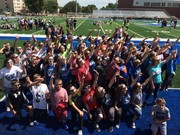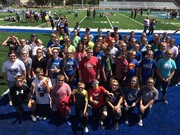Eclipse Can’t Dim Students’ Learning Opportunities
by Rhayna Waldner
On Monday, August 21, a total solar eclipse covered the contiguous United States, with its path going through Nebraska. From coast to coast, the eclipse went from Oregon all the way down to South Carolina. Pierce High School saw this as a great learning opportunity for not only students, but teachers as well.
Although this sounded like a fun activity for classes to do, there were some risks that had to be addressed and some safety restrictions that had to be met. Looking up at the eclipse with the blind eye at any time could result in impaired vision or complete vision loss due to the sun burning holes in the retina. Therefore, special glasses were ordered by the school that were safe for students and teachers who watched the eclipse. Having taken all safety precautions, Pierce High was ready to learn.
The elementary school did some activities in honor of the solar eclipse. Several teachers and volunteers helped supervise students and took turns watching television coverage of the eclipse, and some classes did lessons on the cause of the solar eclipse. Miss Lori Wragge and Mrs. Donna Hoffman also did some experiments with their fourth grade classes and then went out to observe the eclipse.
Mrs. Kathleen Brummels’s Chemistry 1 class and Mrs. Deb Koehlmoos’s Physiology 1 class went outside to observe and record data during the eclipse. The teachers then sent in the data recorded by the students to NASA. They used the school’s iPad minis to take pictures and record cloud cover and temperature. The students were lucky enough to be able to be outside when there was 97% coverage of the sun. Although Chemistry and Physiology don’t have much to do with earth science, the teachers saw this as an opportunity for their students to do something they probably won’t ever get the chance to do again.
The freshman computer apps class, taught by Mrs. Crystal Bauermeister, did many things to prepare for the solar eclipse. On Thursday of last week, the entire class did a hyperdoc where they explored facts and videos from past eclipses, and they were able to enhance their knowledge about them. After doing all of this research, they did a contest to see who could come up with the ten most original facts about solar eclipes. Another thing the class had to do was take home permission slips to their parents so they were able to go outside and conduct experiments safely. On Friday, the class was able to go outside and try on the solar eclipse glasses. On the day of the eclipse, the class took a quiz over myths surrounding the eclipse. Mrs. Bauermeister said, “They all enjoyed the day.”
Mr. Lester Piper took the entire 8th grade class down to the University of Kearney to watch the solar eclipse. The trip was funded by a grant. Kearney was in the path of totality, which means they got 100% coverage for almost two minutes. Mrs. Koehlmoos also went along with them, and so did a few other high school students. When they arrived at UNK, each bus was given a packet that had a meal ticket and eclipse glasses for each person. There were also many fun activities there for the kids to stay busy. There were bounce houses in the south end zone, a games of nine square that used PVC pipe and bungee trampolines. With about twenty minutes left until the eclipse, the students and teachers went up into the stands on the football field and watched the countdown on the scoreboard on the stadium.
“It gets really dark, just like evening time before it goes pitch black. And instead of it looking like a regular sunset that’s only on one side of the earth, it was a 360 degree sunset, that was an amazing to experience.” Mr. Piper said, “It also showed us the difference of three percent. Knowing that it was still very light outside in Pierce as compared to it almost being pitch black in Kearney makes you realize what a difference three percent can make in any circumstance.”


